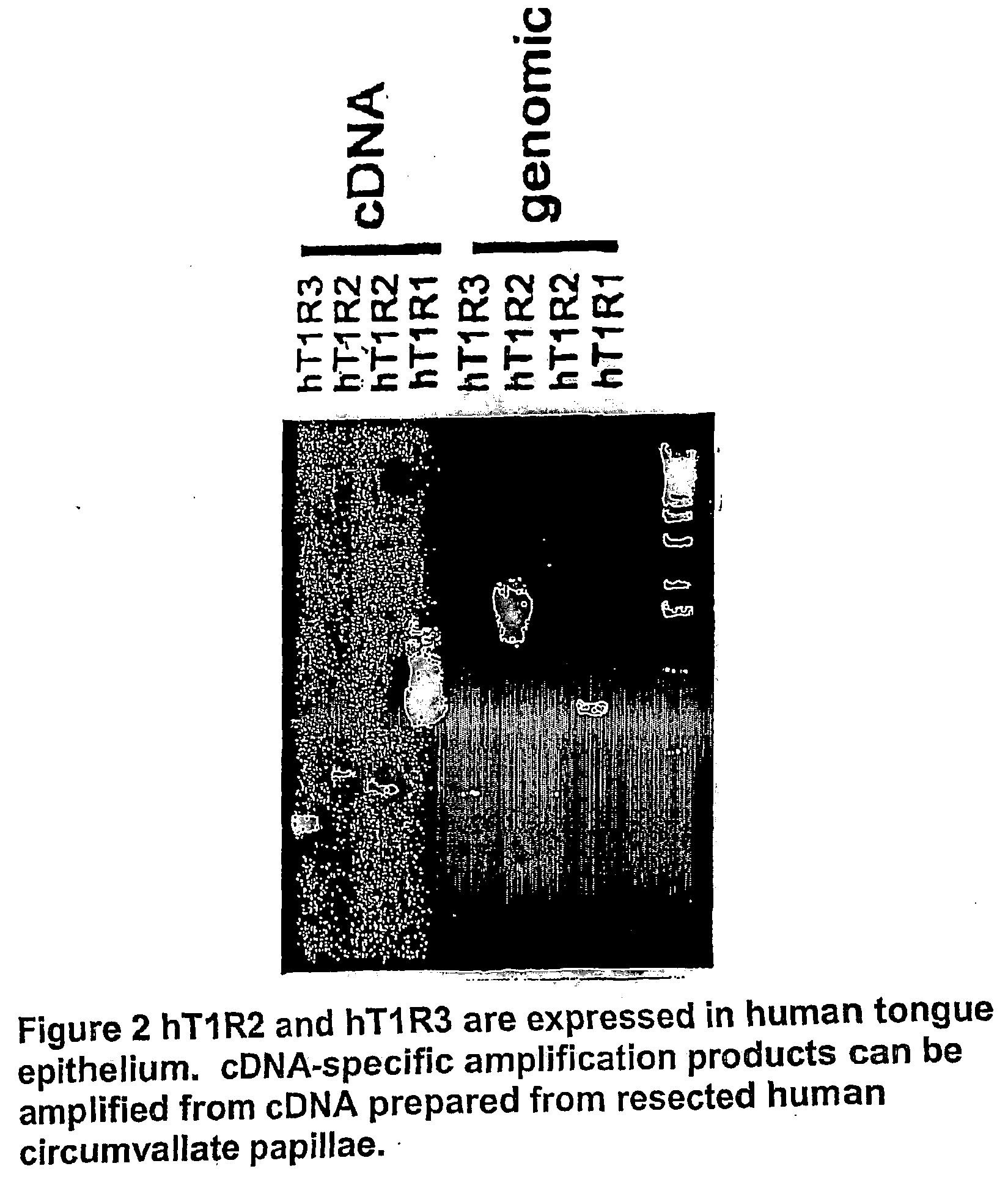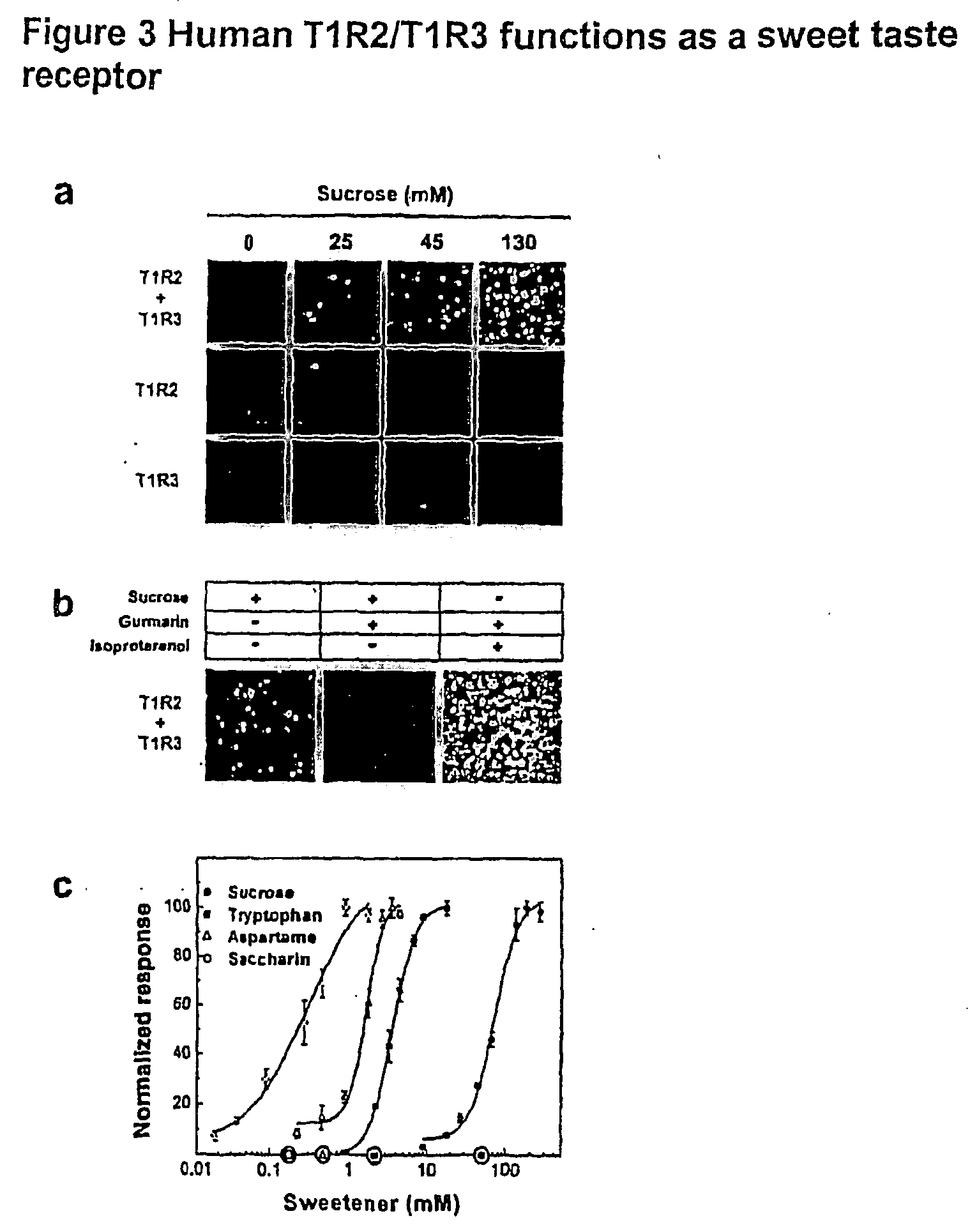T1r hetero-oligomeric taste receptors, cell lines that express said receptors, and taste compounds
a taste receptor and heterooligomeric technology, applied in the field of t1r heterooligomeric taste receptors, cell lines that express said receptors, and taste compounds, can solve the problems of difficult and expensive to isolate and purify from natural sources, little progress has been made in identifying artificial substitutes for msg, and adverse reactions of msg in some people, etc., to achieve high throughput cell-based screening and high throughput
- Summary
- Abstract
- Description
- Claims
- Application Information
AI Technical Summary
Benefits of technology
Problems solved by technology
Method used
Image
Examples
example 1
Production of Intronless HT1R Expression Constructs
[0347] Intronless hT1R expression constructs were cloned by a combination of cDNA-based and genomic DNA-based methods. To generate the fall-length hT1R1 expression construct, two 5′ coding exons identified in a cloned hT1R1 interval (accession # AL159177) were combined by PCR-overlap, and then joined to a 5′-truncated testis cDNA clone. The hT1R2 expression construct was generated from a partially sequenced hT1R2 genomic interval. Two missing hT1R2 5′ exons were identified by screening shotgun libraries of the cloned genomic interval using probes derived from the corresponding rat coding sequence. Coding exons were then combined by PCR-overlap to produce the full-length expression construct. The hT1R3 expression construct was generated by PCR-overlap from a sequenced hT1R3 genomic interval (accession # AL139287). Rat T1R3 was isolated from a rat taste tissue-derived cDNA library using an rT1R3 exon fragment generated by hT1R3-base...
example 2
Sequence Alignment of Human and Rat T1Rs
[0357] Cloned T1R sequences selected from those identified above were aligned against the corresponding rat T1Rs. As shown in FIG. 1, human T1R1, human T1R2 and human T1R3 and rat T1R3 were aligned with previously described T1Rs (rT1R1 having Accession # AAD 18069 and rT1R2 having Accession # AAD 18070), the rat mGluR1 metabotropic, glutamate receptor (Accession # P23385); and the human calcium-sensing receptor (Accession #P41180). For clarity of the comparison, the mGluR1 and calcium-sensing receptor C-termini are truncated. The seven potential transmembrane segments are boxed in blue. Residues that contact the glutamate side-chain carbutylate in the mGluRl crystal structure are boxed in red, and residues that contact the glutamate α-amino acid moiety are boxed in green. The mGluR1 and calcium-sensing receptor cysteine residues implicated in intersubunit disulfide-based formation are circled in purple. These cysteines are not conserved in T...
example 3
Demonstration by RT-PCR that hT1R2 and hT1R3 are Expressed in Taste Tissue
[0358] As shown in FIG. 2, hT1R2 and hT1R3 are expressed in taste tissue: expression of both genes can be detected by RT-PCR from resected human circumvallate papillae.
PUM
| Property | Measurement | Unit |
|---|---|---|
| Tm | aaaaa | aaaaa |
| temperature | aaaaa | aaaaa |
| temperature | aaaaa | aaaaa |
Abstract
Description
Claims
Application Information
 Login to View More
Login to View More - R&D
- Intellectual Property
- Life Sciences
- Materials
- Tech Scout
- Unparalleled Data Quality
- Higher Quality Content
- 60% Fewer Hallucinations
Browse by: Latest US Patents, China's latest patents, Technical Efficacy Thesaurus, Application Domain, Technology Topic, Popular Technical Reports.
© 2025 PatSnap. All rights reserved.Legal|Privacy policy|Modern Slavery Act Transparency Statement|Sitemap|About US| Contact US: help@patsnap.com



